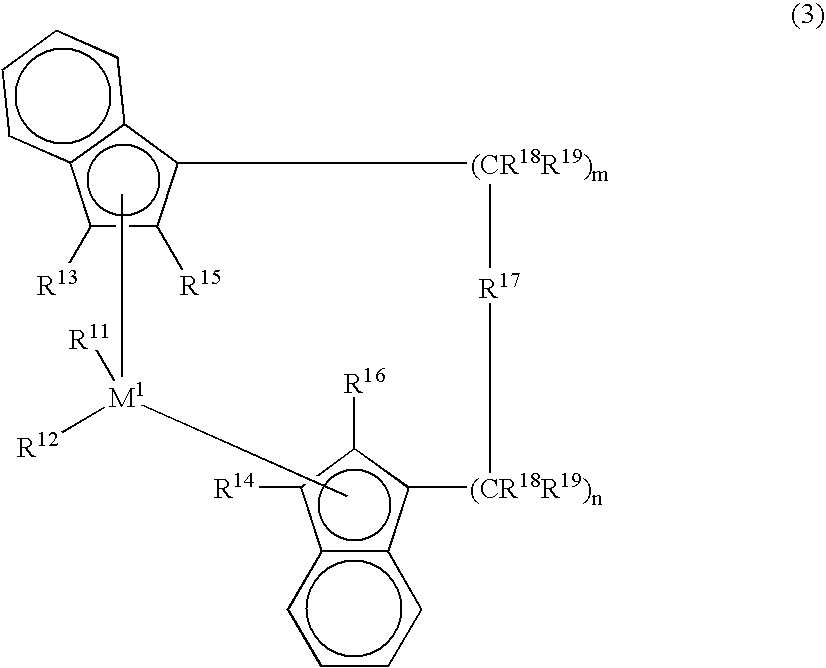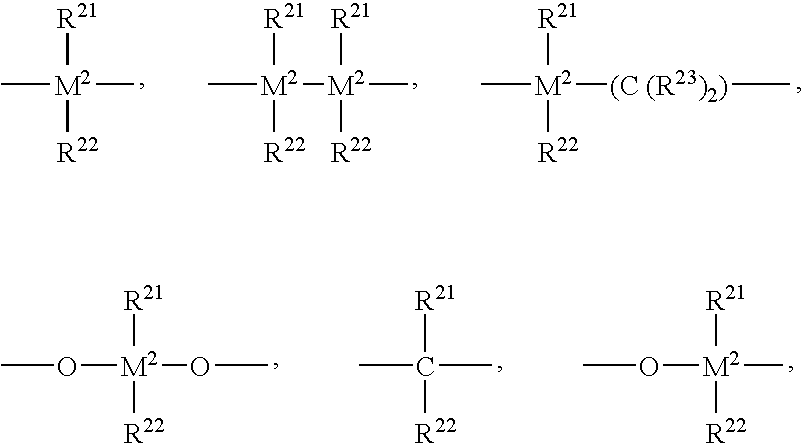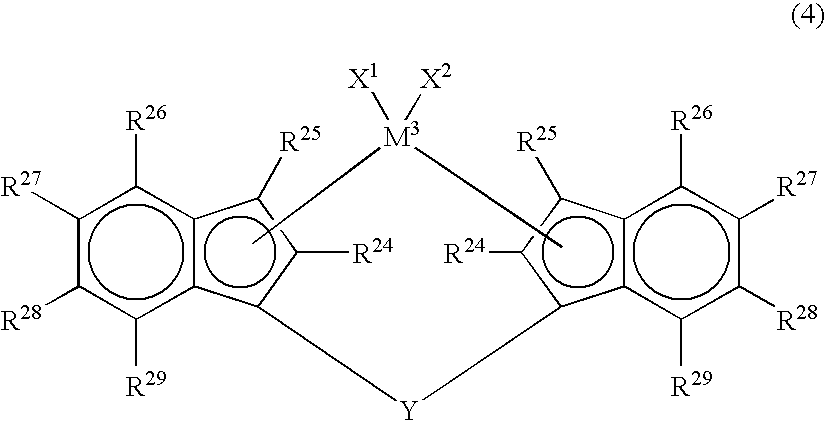Thermoplastic resin composition and molded product from the same
a technology of thermoplastic resin and composition, which is applied in the directions of pharmaceutical delivery mechanism, medical preparations, granular delivery, etc., can solve the problems of difficult to mold olefin resin, difficult to promote the improvement of productivity, and deterioration of the quality of molded articles, so as to reduce the load applied to the screw of an extruder and improve the efficiency of extrusion
- Summary
- Abstract
- Description
- Claims
- Application Information
AI Technical Summary
Benefits of technology
Problems solved by technology
Method used
Image
Examples
example 4
of Metallocene Compound
[0057] As the metallocene compound, a metallocene compound represented by the following formula (5) is also employable.
[0058] In the formula (5), M3 , R24, R25, R26, R27, R28 and R29 are the same as those in the formula (4). Of R26, R27, R28 and R29, two groups including R26 are each preferably an alkyl group, and R26 and R28, or R28 and R29 are each preferably an alkyl group. This alkyl group is preferably a secondary or tertiary alkyl group. Further, this alkyl group may be substituted with a halogen atom or a silicon-containing group. Examples of the halogen atoms and the silicon-containing groups include substituents exemplified with respect to R24 and R25. Of R26, R27, R28 and R29, groups other than the alkyl group are each preferably a hydrogen atom. Two groups selected from R26, R27, R28 and R29 may be bonded to each other to form a monocycle or a polycycle other than the aromatic ring. Examples of the halogen atoms include the same atoms as described...
example 5
of Metallocene Compound
[0062] As the metallocene compound, a metallocene compound represented by the following formula (6) is also employable.
[0063] In the formula (6), M3, R24, X1, X2 and Y are the same as those in the formula (4). R24 is preferably a hydrocarbon group, particularly preferably an alkyl group of 1 to 4 carbon atoms, i.e., methyl, ethyl, propyl or butyl. R25 is an aryl group of 6 to 16 carbon atoms. R25 is preferably phenyl or naphthyl. The aryl group may be substituted with a halogen atom, a hydrocarbon group of 1 to 20 carbon atoms or a halogenated hydrocarbon group of 1 to 20 carbon atom. X1 and X2 are each preferably a halogen atom or a hydrocarbon group of 1 to 20 carbon atoms.
[0064] Examples of the metallocene compounds represented by the formula (6) include:
[0065] rac-dimethylsilylene-bis(4-phenyl-1-indenyl)zirconium dichloride, rac-dimethylsilylene-bis(2-methyl-4-phenyl-1-indenyl)zirconium dichloride, rac-dimethylsilylene-bis(2-methyl-4-(α-naphthyl)-1-ind...
example 6
of Metallocene Compound
[0066] As the metallocene compound, a metallocene compound represented by the following formula (7) is also employable.
LaM4X32 (7)
[0067] In the above formula, M4 is a metal of Group 4 or lanthanide series of the periodic table. La is a derivative of a delocalized π bond group and is a group imparting a constraint geometric shape to the metal M4 active site. Each X3 may be the same or different and is a hydrogen atom, a halogen atom, a hydrocarbon group of 20 or less carbon atoms, a silyl group having 20 or less silicon atoms or a germyl group having 20 or less germanium atoms.
[0068] Of such compounds, a compound represented by the following formula (8) is preferable.
[0069] In the formula (8), M4 is titanium, zirconium or hafnium. X3 is the same as that described in the formula (7). Cp is π-bonded to M4 and is a substituted cyclopentadienyl group having a substituent Z. Z is oxygen, sulfur, boron or an element of Group 4 of the periodic table (e.g., silicon...
PUM
| Property | Measurement | Unit |
|---|---|---|
| melting point | aaaaa | aaaaa |
| melting point | aaaaa | aaaaa |
| density gradient tube process | aaaaa | aaaaa |
Abstract
Description
Claims
Application Information
 Login to View More
Login to View More - R&D
- Intellectual Property
- Life Sciences
- Materials
- Tech Scout
- Unparalleled Data Quality
- Higher Quality Content
- 60% Fewer Hallucinations
Browse by: Latest US Patents, China's latest patents, Technical Efficacy Thesaurus, Application Domain, Technology Topic, Popular Technical Reports.
© 2025 PatSnap. All rights reserved.Legal|Privacy policy|Modern Slavery Act Transparency Statement|Sitemap|About US| Contact US: help@patsnap.com



